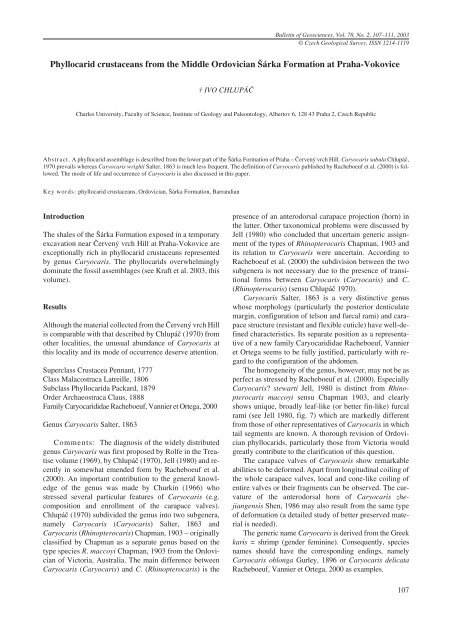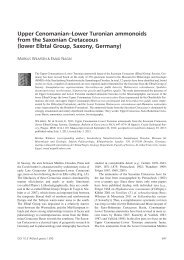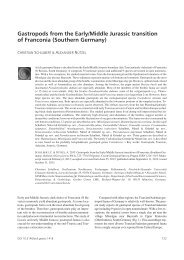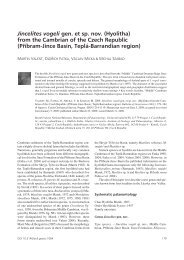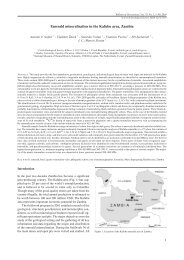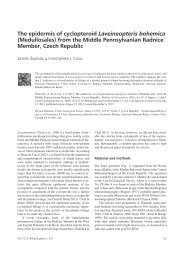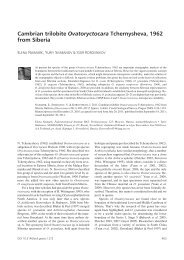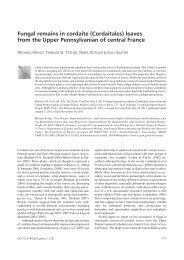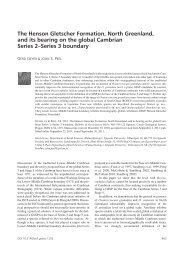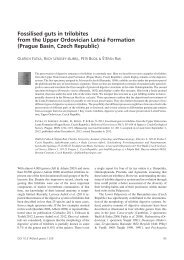full text (PDF, 0.29 MB)
full text (PDF, 0.29 MB)
full text (PDF, 0.29 MB)
Create successful ePaper yourself
Turn your PDF publications into a flip-book with our unique Google optimized e-Paper software.
Bulletin of Geosciences, Vol. 78, No. 2, 107–111, 2003<br />
© Czech Geological Survey, ISSN 1214-1119<br />
Phyllocarid crustaceans from the Middle Ordovician Šárka Formation at Praha-Vokovice<br />
† IVO CHLUPÁČ<br />
Charles University, Faculty of Science, Institute of Geology and Paleontology, Albertov 6, 128 43 Praha 2, Czech Republic<br />
Abstract. Aphyllocarid assemblage is described from the lower part of the Šárka Formation of Praha – Červený vrch Hill. Caryocaris subula Chlupáč,<br />
1970 prevails whereas Caryocaris wrighti Salter, 1863 is much less frequent. The definition of Caryocaris published by Racheboeuf et al. (2000) is followed.<br />
The mode of life and occurrence of Caryocaris is also discussed in this paper.<br />
Key words: phyllocarid crustaceans, Ordovician, Šárka Formation, Barrandian<br />
Introduction<br />
The shales of the Šárka Formation exposed in a temporary<br />
excavation near Červený vrch Hill at Praha-Vokovice are<br />
exceptionally rich in phyllocarid crustaceans represented<br />
by genus Caryocaris. The phyllocarids overwhelmingly<br />
dominate the fossil assemblages (see Kraft et al. 2003, this<br />
volume).<br />
Results<br />
Although the material collected from the Červený vrch Hill<br />
is comparable with that described by Chlupáč (1970) from<br />
other localities, the unusual abundance of Caryocaris at<br />
this locality and its mode of occurrence deserve attention.<br />
Superclass Crustacea Pennant, 1777<br />
Class Malacostraca Latreille, 1806<br />
Subclass Phyllocarida Packard, 1879<br />
Order Archaeostraca Claus, 1888<br />
Family Caryocarididae Racheboeuf, Vannier et Ortega, 2000<br />
Genus Caryocaris Salter, 1863<br />
Comments: The diagnosis of the widely distributed<br />
genus Caryocaris was first proposed by Rolfe in the Treatise<br />
volume (1969), by Chlupáč (1970), Jell (1980) and recently<br />
in somewhat emended form by Racheboeuf et al.<br />
(2000). An important contribution to the general knowledge<br />
of the genus was made by Churkin (1966) who<br />
stressed several particular features of Caryocaris (e.g.<br />
composition and enrollment of the carapace valves).<br />
Chlupáč (1970) subdivided the genus into two subgenera,<br />
namely Caryocaris (Caryocaris) Salter, 1863 and<br />
Caryocaris (Rhinopterocaris) Chapman, 1903 – originally<br />
classified by Chapman as a separate genus based on the<br />
type species R. maccoyi Chapman, 1903 from the Ordovician<br />
of Victoria, Australia. The main difference between<br />
Caryocaris (Caryocaris) and C. (Rhinopterocaris) isthe<br />
presence of an anterodorsal carapace projection (horn) in<br />
the latter. Other taxonomical problems were discussed by<br />
Jell (1980) who concluded that uncertain generic assignment<br />
of the types of Rhinopterocaris Chapman, 1903 and<br />
its relation to Caryocaris were uncertain. According to<br />
Racheboeuf et al. (2000) the subdivision between the two<br />
subgenera is not necessary due to the presence of transitional<br />
forms between Caryocaris (Caryocaris) and C.<br />
(Rhinopterocaris) (sensu Chlupáč 1970).<br />
Caryocaris Salter, 1863 is a very distinctive genus<br />
whose morphology (particularly the posterior denticulate<br />
margin, configuration of telson and furcal rami) and carapace<br />
structure (resistant and flexible cuticle) have well-defined<br />
characteristics. Its separate position as a representative<br />
of a new family Caryocarididae Racheboeuf, Vannier<br />
et Ortega seems to be <strong>full</strong>y justified, particularly with regard<br />
to the configuration of the abdomen.<br />
The homogeneity of the genus, however, may not be as<br />
perfect as stressed by Racheboeuf et al. (2000). Especially<br />
Caryocaris? stewarti Jell, 1980 is distinct from Rhinopterocaris<br />
maccoyi sensu Chapman 1903, and clearly<br />
shows unique, broadly leaf-like (or better fin-like) furcal<br />
rami (see Jell 1980, fig. 7) which are markedly different<br />
from those of other representatives of Caryocaris in which<br />
tail segments are known. A thorough revision of Ordovician<br />
phyllocarids, particularly those from Victoria would<br />
greatly contribute to the clarification of this question.<br />
The carapace valves of Caryocaris show remarkable<br />
abilities to be deformed. Apart from longitudinal coiling of<br />
the whole carapace valves, local and cone-like coiling of<br />
entire valves or their fragments can be observed. The curvature<br />
of the anterodorsal horn of Caryocaris zhejiangensis<br />
Shen, 1986 may also result from the same type<br />
of deformation (a detailed study of better preserved material<br />
is needed).<br />
The generic name Caryocaris is derived from the Greek<br />
karis = shrimp (gender feminine). Consequently, species<br />
names should have the corresponding endings, namely<br />
Caryocaris oblonga Gurley, 1896 or Caryocaris delicata<br />
Racheboeuf, Vannier et Ortega, 2000 as examples.<br />
107
† Ivo Chlupáč<br />
Occurrence: Caryocaris is a world-wide distributed<br />
genus (Vannier et al. in press) known particularly from the<br />
Lower and Middle Ordovician rocks of Europe (England,<br />
Scotland?, Bohemia, Norway, Germany), North America<br />
(Alaska, Nevada, Idaho, Canada), Asia (China – Zhejiang),<br />
Australia (Victoria, New Zealand) and South America<br />
(Bolivia, Argentina). It is reported to occur also in the Upper<br />
Ordovician of Peru (Bulman 1931). The last and rare<br />
occurrences of Caryocaris in the Barrandian are Upper Ordovician<br />
in age (unpublished new material). The youngest<br />
occurrence has been reported from the Lower Silurian of<br />
the Canadian Arctic (Cornwallis Island, Copeland 1967).<br />
Although the reference to Caryocaris is correct, the dating<br />
of the phyllocarid-bearing strata (Wenlockian according to<br />
graptolites found nearby) needs to be re-examined. The<br />
maximum development of Caryocaris clearly falls within<br />
the interval Arenigian–Llanvirnian (or better Arenigian to<br />
Darriwillian, as some frequent occurrences are younger<br />
than the original Llanvirnian).<br />
Caryocaris subula Chlupáč, 1970<br />
Plate I, figs. 1–4<br />
1970 Caryocaris (Rhinopterocaris) subula sp. n., Chlupáč,<br />
p. 55–59, <strong>text</strong>-fig. 7, 8, 9 pl. 5, figs. 1–10, pl. 6,<br />
figs. 1–5, pl. 7, figs. 1–7.<br />
2000 Caryocaris subula Chlupáč, 1970, Racheboeuf,<br />
Vannier et Ortega, p. 323, 331, <strong>text</strong>-fig. 13B.<br />
Remarks: The description and affinities of this characteristic<br />
and frequent species have been already presented<br />
by Chlupáč (1970). The new material from the excavation<br />
at Praha – Červený vrch Hill is very similar to that from<br />
Praha-Jenerálka (Na Salátce, former brickyard quarry)<br />
where this species frequently occurs in roughly coeval<br />
level (lower part of the Šárka Formation, Corymbograptus<br />
retroflexus Zone).<br />
Fifty relatively undistorted specimens were selected<br />
from a large amount of collected specimens. The length of<br />
their carapace (without anterior horn and posterodorsal<br />
spine) ranges between 3 and 10 mm, the dorsoventral width<br />
between 1.3 to 4.2 mm (the width seems to be more<br />
strongly affected by deformation than the length). The carapace<br />
horn is often entirely or partly broken off, but specimens<br />
with a well-preserved horn corresponding to the reconstruction<br />
(see Chlupáč 1970, <strong>text</strong>-fig. 7) are abundant<br />
in the new material described herein. Isolated anterior<br />
horns are commonly found as fragments along with broken<br />
anterior parts of isolated carapace valves.<br />
Abdominal segments were not found in connection<br />
with the tail-pieces. Short segments are preserved as isolated<br />
bands, often fragmented. Abdominal segments connected<br />
with caudal spines are rare. Typical is the specimen<br />
on Plate I, fig. 4, which preserves 5 to 6 narrow segments of<br />
subquadrate outline (the two anteriormost fragmentary),<br />
followed by a conical telson (2.5 mm long) and a pair of<br />
furcal rami (4.1 mm in length; measured along the outer<br />
margin). The length of the conical telson of 8 other specimens<br />
ranges between 1 and 4 mm, two specimens show a<br />
medial longitudinal keel but the effect of deformation cannot<br />
be excluded. Flame-like and flat furcal rami bear only<br />
seldom well-preserved, short, posteriorly directed spinules<br />
on the outer side; setae on the inner side of furcal rami were<br />
not observed (probably broken off during transportation?).<br />
Although several hundreds of specimens were examined,<br />
none show the carapace valves in direct and clear<br />
connection with the abdomen. The situation is similar at all<br />
other Bohemian localities where Caryocaris occurs (see<br />
discussion below). Noteworthy is the above mentioned<br />
specimen, connected with caudal spines in close proximity<br />
with laterally flattened carapace valves (most probably the<br />
same specimen). This recalls two other specimens<br />
(ICh571, ICh599) previously described as Caryocaris<br />
wrighti by Chlupáč (1970, <strong>text</strong>-fig. 3) and confirms the<br />
conspecificity of the carapace valves with the abdominal<br />
parts repeatedly found close to them. The question of the<br />
number of abdominal segments extending outside from the<br />
carapace posteriorly, however, remains open (the abdominal<br />
part protruding from the carapace may not be necessarily<br />
as short as it is depicted in the reconstructions of C.<br />
wrighti and C. subula made by Racheboeuf et al. 2000,<br />
figs. 13A, B).<br />
In agreement with other, previously described specimens<br />
of C. subula, our new specimens do not show typical<br />
longitudinal enrollment of Caryocaris curvilata and C.<br />
wrighti (see Churkin 1966, Chlupáč 1970). This is most<br />
likely due to the relatively smaller size (smaller than C.<br />
wrighti) and rather oval shape of the carapace valves of C.<br />
subula which were strengthened by the prominent anterior<br />
horn. However, the carapaces of C. subula and C. wrighti<br />
are both thin and evidently of the same composition. They<br />
are typically preserved as dark and glittering matter.<br />
C. subula is by far the most frequent fossil find in the<br />
studied shales (Šárka Formation at Praha – Červený vrch<br />
Hill). Its remains are often concentrated on bedding planes<br />
or form clusters of several tens (often 20 to 50, sometimes<br />
more) of specimens. These peculiar occurrences are discussed<br />
in the paleoecology section of the present paper.<br />
Caryocaris wrighti Salter, 1863<br />
Plate I, figs. 5–8<br />
Synonymy: see Chlupáč, 1970, p. 45.<br />
Remarks: By comparison with C. subula, this typical<br />
and widely distributed species is markedly less common at<br />
the studied locality. The recently collected specimens<br />
agree in all main features with those previously described<br />
from the Bohemian Ordovician (Chlupáč 1970).<br />
The characteristic features of C. wrighti are as follows:<br />
The pod-shaped carapace valves with simply pointed<br />
anterodorsal part without marked anterior horn, well-defined<br />
ventral border delimited by a border furrow,<br />
dorso-ventrally truncated posterior margin with two small<br />
(posterodorsal and posteroventral) spines and numerous<br />
(more than thirty) very tiny spinules tightly arranged be-<br />
108
Phyllocarid crustaceans from the Middle Ordovician Šárka Formation at Praha-Vokovice<br />
tween them. The abdomen consists of short segments of<br />
subcircular transversal cross-section and equal sagittal<br />
length (pretelson is not prolonged), a conical, posteriorly<br />
rapidly tapering telson, and flat, flame-like furcal rami with<br />
few (max. 5) short outer spines and numerous setae bordering<br />
the inner margin.<br />
The largest carapace valves found in our new collections<br />
are compressed laterally (length = 23 or 24 mm, dorsoventral<br />
width = 9 mm). The length of other carapace<br />
valves ranges between 14 and 20 mm. These measurements<br />
fall within the common size ranges of C. wrighti<br />
given by Chlupáč (1970). Very obvious is the longitudinal<br />
enrollment of carapace valves which was well described in<br />
C. curvilata from Alaska by Churkin (1966) and also in C.<br />
wrighti from the Barrandian (Chlupáč 1970).<br />
The collected caudal spines, namely telsons and furcal<br />
rami are similar to those described earlier (Chlupáč1970).<br />
It is not certain that they belong to C. wrighti. These elements,<br />
when isolated, are difficult to distinguish from those<br />
of C. subula.<br />
Palaeoecological and general notes<br />
Caryocaris is a widely distributed crustacean in the Lower<br />
and Middle Ordovician. It is generally regarded a pelagic<br />
component of marine fauna, typically associated with<br />
graptolites in the graptolitic shale facies (Stormer 1937,<br />
Racheboeuf et al. 2000, Vannier et al. in press).<br />
In the Ordovician of the Barrandian area, Caryocaris<br />
are confined to dark grey shales with silty intervals.<br />
Caryocaris often occurs in shales with strongly impoverished<br />
benthos. Typical examples were given by Chlupáč<br />
(1970) at Praha-Jenerálka (Na Salátce) and by our new exposures<br />
at Praha – Červený vrch Hill. At some localities it<br />
is associated with rather diverse benthic forms (trilobites,<br />
brachiopods, gastropods, hyolithids, bivalves and echinoderms).<br />
This is the case of classical localities near of<br />
Rokycany, such as Šárka (see Chlupáč 1970). This points<br />
to a certain tolerance or lesser dependence on depth conditions,<br />
which agrees with the wide geographic distribution<br />
of Caryocaris.<br />
However, Caryocaris is almost invariably associated<br />
with the shale facies. Caryocaris is absent (or extremely<br />
rare) in the nearshore and high-energy, shallow-water sandstone<br />
(quartzite) facies of the Barrandian Ordovician (the<br />
Skalka Quartzite replacing the Caryocaris-bearing shale facies<br />
of the Dobrotivá Formation as a typical example).<br />
Caryocaris has been generally regarded as a planktonic<br />
animal, although Bulman’s (1964) opinion is more reserved.<br />
Chlupáč (1970) regarded Caryocaris as a probable<br />
epiplanktic organism which may have been attached to<br />
floating algal thali in the upper photic zone near the water<br />
surface. This does not mean that Caryocaris was not an active<br />
swimmer (see Vannier et al. 1997), but its best life conditions<br />
were probably associated with algal carpets in the<br />
uppermost part of the water column. This explanation corresponds<br />
to the frequent occurrences of clusters of Caryocaris<br />
remains (e.g. our new locality). Recently, Racheboeuf<br />
et al. (2000) discussed the problem of exuviae and<br />
their tendency to coil longitudinally. Their conclusions are<br />
consistent with the mode of preservation of Caryocaris<br />
wrighti in the Barrandian.<br />
The fact that no complete specimen with connected<br />
carapace and abdomen was found among hundreds of specimens<br />
collected or examined in the field indicates a<br />
post-mortem transportation. This is also supported by finds<br />
of large bedding planes crowded with Caryocaris remains,<br />
where complete carapace valves are present together with<br />
markedly fragmented remains (see Plate I, fig. 3).<br />
The markedly impoverished and less frequent associated<br />
fauna consisting of graptolites, dendroids, small<br />
inarticulates and other rare fossils points to a pelagic environment<br />
episodically affected by currents whose direction<br />
cannot be reconstructed (e.g., from the linear arrangement<br />
of fossil remains or from the input of typical shallow-water<br />
inhabitants).<br />
The grain-size gradients are low, and together with the<br />
fine lamination point to rather quiet conditions in deeperwater<br />
and dysoxic environments, not suitable for the<br />
benthos. These characteristics seem to correspond to the<br />
lower part of the Šárka Formation (study area) and cannot<br />
be generalized for the whole formation, for example the<br />
Bouček’s (1927) interval 3 in the former Vokovice<br />
brickyard. Fauna from other classical fossiliferous localities<br />
of the Šárka Formation evidently reflects a more suitable<br />
environment with more diverse benthic assemblages<br />
(the Euorthisina Community sensu Havlíček 1982 =<br />
Euorthisina-Placoparia Community sensu Havlíček and<br />
Vaněk 1990, see also Havlíček 1998).<br />
The extreme abundance of Caryocaris at the studied locality<br />
and elsewhere would <strong>full</strong>y justify the term<br />
“Caryocaris Shale”. These shales differ from typical graptolitic<br />
shales in a lesser content of organic carbon (consequently,<br />
the colour is grey, not black), a higher amount of<br />
silt component, and less frequent graptolites whose frequency<br />
is far behind the remains of Caryocaris. According<br />
to the Boucot’s (1975) classification the studied<br />
Caryocaris-bearing rocks in the studied section belong to<br />
the pelagic realm with Benthic Assemblage 6, most likely<br />
the open-shelf environment.<br />
The wide and cosmopolitan distribution of Caryocaris<br />
has its counterpart in the Cambrian Isoxys Walcott, 1990<br />
(see Williams et al. 1996, Vannier et al. 1997, Vannier and<br />
Chen 2000), whose morphology of carapace valves shows<br />
clear similarities (anterodorsal and posterodorsal spines,<br />
rather small size, etc.), though its systematic position was<br />
different and the Cambrian pelagic life generally less advanced.<br />
Another remarkable feature concerns the stratigraphic<br />
occurrence of Caryocaris. The world-wide distribution of<br />
Caryocaris in the Arenigian and Darriwilian (former<br />
Llanvirnian to Llandeilian) strata (see Chlupáč 1970,<br />
Racheboeuf et al. 2000, Vannier et al. in press) contrasts<br />
markedly with the very sporadic occurrences of the genus<br />
in younger strata. A typical example is the Barrandian area,<br />
109
† Ivo Chlupáč<br />
where Caryocaris belongs to the most common fossils in<br />
the shale facies of the Klabava (Arenigian) up to Dobrotivá<br />
(“Llandeilian” = upper Darriwilian) formations. It becomes<br />
rare starting from the Libeň Formation correlated<br />
with the earliest Caradocian: it belongs to expressive rarities,<br />
although the lithology of the shale facies remains similar<br />
to that of the underlying formations (the same concerns<br />
younger units, namely the Vinice and Bohdalec formations).<br />
This might indicate an environmental change (possibly<br />
water chemistry or temperature), markedly unfavourable<br />
for Caryocaris. The decreasing frequency of<br />
Caryocaris may be related to some global event, which<br />
might have affected also other pelagic forms.<br />
Editorial acknowledgment<br />
We would like to express many thanks to Dr. Jean Vannier,<br />
CNRS, France, who substantially helped us with the review<br />
and revision of the manuscript.<br />
References<br />
Bouček B. (1927): Contribution a la connaissance de la stratigraphie des<br />
couches de Šárka – d γ1 de l’Ordovicien de la Bohême. Bull. intern.<br />
Acad. tchéque Sci. 27, 537–544.<br />
Boucot A. J. (1975): Evolution and extinction rate controls. Elsevier, Amsterdam.<br />
Bulman O. M. B. (1931): South American graptolites with special references<br />
to the Nordenskiöld collection. Arkiv f. Zoologi 22A, 1–111.<br />
Bulman O. M. B. (1964): Lower Palaeozoic plankton. Quart. J. Geol. Soc.<br />
Lond. 120, 455–476.<br />
Chapman F. (1903): New or little known Victorian fossils in the National<br />
Museum, I. Some Palaeozoic species. Proceed. Royal Soc. Victoria<br />
15, 104–122.<br />
Chlupáč I. (1970): Phyllocarid crustaceans of the Bohemian Ordovician.<br />
Sbor. geol. Věd, Paleont. 12, 41–75.<br />
Churkin M., Jr. (1966): Morphology and stratigraphic range of the<br />
phyllocarid crustacean Caryocaris from Alaska and the Great Basin.<br />
Palaeontology 9, 3, 371–380.<br />
Copeland M. J. (1967): An occurrence of Caryocaris (Crustacea,<br />
Phyllocarida) from the Canadian Arctic. J. Paleont. 41, 5,<br />
1193–1194.<br />
Havlíček V. (1982): Ordovician in Bohemia: Development of the Prague<br />
Basin and its benthic communities. Sbor. geol. Věd, Geol. 37,<br />
103–136.<br />
Havlíček V. (1998): Ordovician. In: Chlupáč I. et al. (ed.) Palaeozoic of<br />
the Barrandian (Cambrian to Devonian), 41–79. Czech Geological<br />
Survey, Prague.<br />
Havlíček V., Vaněk J. (1990): Ordovician invertebrate communities in<br />
black shale lithofacies (Prague Basin, Czechoslovakia). Věst. Ústř.<br />
Úst. geol. 65, 223–236.<br />
Jell P. A. (1980): Two arthropods from the Lancefieldian (La 1) of central<br />
Victoria. Alcheringa 4, 37–46.<br />
Kraft P., Budil P., Chlupáč I., Fatka O., Kraft J., Mikuláš R., Mergl M.,<br />
Bruthansová J. (2003): Fossil assemblages from the Middle Ordovician<br />
Šárka Formation at Praha – Červený vrch Hill (Prague Basin,<br />
Barrandian area). Bull. Geosci. 78, 2, 99–101.<br />
Racheboeuf P., Vannier J., Ortega G. (2000): Ordovician phyllocarids<br />
(Arthropoda, Crustacea) from Argentina. Paläont. Zeitschr. 74, 3,<br />
317–333.<br />
Rolfe W. D. I. (1969): Phyllocarida. In: Moore R. C. (ed.) Treatise on Invertebrate<br />
Paleontology, Part R, Arthropoda 4, 1, R296-R331. Geol.<br />
Soc. Amer., Univ. Kansas Press.<br />
Shen, Yanbin (1986): Caryocaris from the Lower Ordovician of<br />
Jiangshan, Zhejiang. Kexue Tongbao 31, 11, 765–769.<br />
Stormer L. (1937): Planktonic crustaceans from the Lower Didymograptus<br />
Shale (3b) of Oslo. Nor. geol. Tidsskr 16, 1936, 267–278.<br />
Vannier J., Boissy P., Racheboeuf, P. R. (1997): Locomotion in Nebalia<br />
bipes: a possible model for Palaeozoic phyllocarid Crustaceans.<br />
Lethaia 30, 89–104.<br />
Vannier J., Chen J. Y. (2000): The early Cambrian colonization of pelagic<br />
niches exemplified by Isoxys (Arthropoda). Lethaia 33,<br />
295–311.<br />
Vannier J., Racheboeuf P. R., Brussa E. D., Williams M., Rushton A.<br />
W. A., Servais T., Siveter D. J. (in press): Cosmopolitan arthropod<br />
zooplankton in the Ordovician seas. Pal. Pal. Pal.<br />
Williams M., Siveter D. J., Peel J. S. (1996): Isoxys (Arthropoda) from the<br />
early Cambrian Sirius Passet Lagerstätte, North Greenland. J.<br />
Paleont. 70, 6, 947–954.<br />
Handling editor: Petr Budil<br />
Plate I<br />
→<br />
1–Caryocaris subula Chlupáč (1970), left valve of carapace (ICh 7155) with deformed tailpiece and remains of posterior abdominal segments preserved<br />
in dark grey shale, Červený vrch Hill in Prague, Šárka Formation. 2 – Caryocaris cf. subula Chlupáč (1970), tailpiece and remains of posterior abdominal<br />
segments (ICh 7156) in dark grey shale, Červený vrch Hill in Prague, Šárka Formation. 3 – Caryocaris subula Chlupáč (1970), accumulation of carapaces<br />
(ICh 7157) in dark grey shale, Červený vrch Hill in Prague, Šárka Formation. 4 – Caryocaris cf. subula Chlupáč (1970), tailpiece and remains of posterior<br />
abdominal segments (ICh 7158) in dark grey shale, Červený vrch Hill in Prague, Šárka Formation. 5 – Caryocaris cf. wrighti Salter (1863), tailpiece and<br />
remains of posterior abdominal segments (ICh 7159) in dark grey shale, Červený vrch Hill in Prague, Šárka Formation. 6 – Caryocaris cf. wrighti Salter<br />
(1863), tailpiece and remains of posterior abdominal segments (ICh 7160) in dark grey shale, Červený vrch Hill in Prague, Šárka Formation.<br />
7–Caryocaris wrighti Salter (1863), left valve of carapace (ICh 7161) with tailpiece and remains of posterior abdominal segments in dark grey shale,<br />
Červený vrch Hill in Prague, Šárka Formation. 8 – Caryocaris cf. wrighti Salter (1863), tailpiece and remains of posterior abdominal segments (ICh 7162)<br />
in dark grey shale, Červený vrch Hill in Prague, Šárka Formation. Photographed by F. Vacek.<br />
110
Phyllocarid crustaceans from the Middle Ordovician Šárka Formation at Praha-Vokovice<br />
1 2<br />
3<br />
4<br />
5 6<br />
7 8<br />
111


